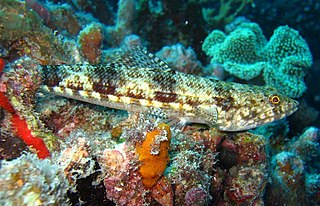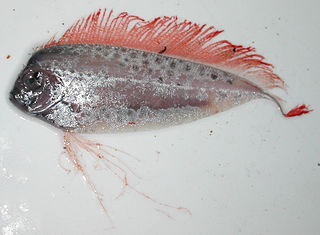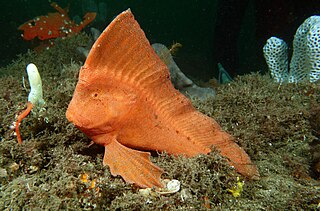
Aulopiformes is a diverse order of marine ray-finned fish consisting of some 15 extant and several prehistoric families with about 45 genera and over 230 species. The common names grinners, lizardfishes and allies, or aulopiforms are sometimes used for this group. The scientific name means "Aulopus-shaped", from Aulopus + the standard fish order suffix "-formes". It ultimately derives from Ancient Greek aulós + Latin forma, the former in reference to the elongated shape of many aulopiforms.

Marine hatchetfishes or deep-sea hatchetfishes are small deep-sea mesopelagic ray-finned fish of the stomiiform subfamily Sternoptychinae. They should not be confused with the freshwater hatchetfishes, which are not particularly closely related Teleostei in the characiform family Gasteropelecidae.

The goatfishes are fish of the family Mullidae, the only family in the order Mulliformes. The family is also sometimes referred to as the red mullets, which also refers more narrowly to the genus Mullus.

Pinecone fishes are small and unusual marine fish of the family Monocentridae. The family contains just four species in two genera, one of which is monotypic. Their distribution is limited to tropical and subtropical waters of the Indo-Pacific. Pinecone fishes are popular subjects of public aquaria, but are both expensive and considered a challenge for the hobbyist to maintain.
Pearlfish are marine fish in the ray-finned fish family Carapidae. Pearlfishes inhabit the tropical waters of the Atlantic, Indian, and Pacific Oceans at depths to 2,000 m (6,600 ft), along oceanic shelves and slopes. They are slender, elongated fish with no scales, translucent bodies, and dorsal fin rays which are shorter than their anal fin rays. Adults of most species live symbiotically inside various invertebrate hosts, and some live parasitically inside sea cucumbers. The larvae are free living.

The ribbonfish are any lampriform fishes in the family Trachipteridae. There are about 10 recognized species in the family. These pelagic fish are named for their slim, ribbon-like appearance. They are rarely seen alive, as they typically live in deep waters, though are not bottom feeders. The perciform fish known as the red bandfish is sometimes referred to as ribbonfish, but it is unrelated to any ribbonfish in the Trachipteridae.

The Synodontidae or lizardfishes are benthic (bottom-dwelling) marine and estuarine bony fishes that belong to the aulopiform fish order, a diverse group of marine ray-finned fish consisting of some 15 extant and several prehistoric families. They are found in tropical and subtropical marine waters throughout the world.

Congiopodidae, commonly known as pigfishes, horsefishes and racehorses, is a family of ray-finned fish classified with in the order Perciformes. These fishes are native to the Southern Hemisphere.
The Bathydraconidae, or the Antarctic dragonfishes, are a family of marine ray-finned fishes, notothenioids belonging to the Perciform suborder Notothenioidei. The family comprises four genera. These fishes are endemic to deep waters off Antarctica.

Ogcocephalidae is a family of anglerfish specifically adapted for a benthic lifestyle of crawling about on the seafloor. Ogcocephalid anglerfish are sometimes referred to as batfishes, deep-sea batfishes, handfishes, and seabats. They are found in tropical and subtropical oceans worldwide. They are mostly found at depths between 200 and 3,000 m, but have been recorded as deep as 4,000 m (13,000 ft). A few species live in much shallower coastal waters and, exceptionally, may enter river estuaries.

The Australian prowfishes are a small family, the Pataecidae, of ray-finned fishes classified within the order Scorpaeniformes. Australian prowfishes are distinguished by a long dorsal fin that begins far forward on the head, forming a "prow" shape, and extends all the way to the caudal fin. They lack scales and pelvic fins.

Little velvetfishes or simply velvetfishes are a family, the Aploactinidae, of marine ray-finned fishes classified within the order Scorpaeniformes. They are small fish that have skin with a velvet texture. They live on the sea bottom close to the shore, at depths of up to 100 metres (330 ft). They are found in the Indo-Pacific region.

Emmelichthyidae is a small family of small to medium-sized marine ray-finned fishes known commonly as rovers, bonnetmouths or rubyfishes.

Caesionidae, the fusiliers, are a family of marine ray-finned fishes in the order Perciformes. The family includes about 23 species. They are related to the snappers, but adapted for feeding on plankton, rather than on larger prey. They are found at reefs in the Indo-Pacific and in the Red Sea.

The spikefishes are ray-finned fishes related to the pufferfishes and triggerfishes. They live in deep waters; more than 50 m (160 ft), but above the continental shelves. They are found in the Atlantic, Indian Ocean, and the west-central Pacific.
The pearleyes are a family, Scopelarchidae, of aulopiform ray-finned fish, distinguished by their unique visual system, with two retinas in each eye.

The Aulopidae are a small family of aulopiform ray-finned fish. They are found in most tropical and subtropical oceans, and are commonly known as flagfins.

Paraploactis is a genus of marine ray-finned fish, velvetfishes belonging to the family Aploactinidae. The genus is found the Indo-Pacific.

The smooth lumpfish is a species of marine ray-finned fish belonging to the family Cyclopteridae, the lumpfishes and lumpsuckers. This species is found in the northern Pacific Ocean. It is the only species in the monospecific genus Aptocyclus.

Apsilus is a small genus of marine ray-finned fish, snappers belonging to the family Lutjanidae. The two species within the genus are native to the Atlantic Ocean,

















